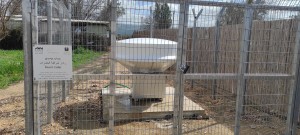The first insect radar of its kind in Israel offers a chance to gauge the quantity of insects in Israel’s skies, something that could not previously be calculated. The new radar was installed close to the Agamon Hula by researchers from the Department of Evolutionary and Environmental Biology at the University of Haifa. The device will allow researchers to estimate the density, direction and speed of migration, elevation, and body size of the insects, and to assess factors influencing the insects that fly in this area. “This is the only radar that is capable of providing us with comprehensive information about the movement of insects in the air. We will be able to measure the flow of insects that migrate in huge numbers for much of the year. We will also be able to identify pollinating insets that are of great importance for wild plants and agriculture, as well as other insects that cause damage to agriculture, such as various species of moths,” explained Prof. Nir Sapir of the Department of Evolutionary and Environmental Biology at the University of Haifa.
One of the first studies undertaken by the researchers with the help of the insect radar seeks to monitor the Fall Armyworm, an invasive species of moth that arrived in Israel recently from South America. Prof. Sapir explains that this species is one of the most harmful in the world and is known to cause damage to more than 350 species of plants. “The crop that is worst affected by the Fall Armyworm larvae is maize. In cooperation with Dr. Liora Shaltiel-Harpaz of Tel Hai College and MIGAL, and with other researchers from various institutions, we have begun to use the radar in order to understand the movement of these moths, as a first step toward controlling their spread,” Prof. Sapir commented.
Insects are very small creatures that cannot easily be identified using regular radars, such as those used to monitor birds. “The unique feature of the insect radar is that it emits a very narrow ray capable of concentrating a large quantity of energy in a limited area, together with a vertical ray directed upward in order to prevent rebounds from the surroundings,” Prof. Sapir explained.
Using such variables as size, flight speed, wing movement pattern, and body shape obtained from the radar, the researchers plan to apply a classification tool based on “teaching” the machine to identify groups of insects and later on specific species, such as the Fall Armyworm, with the help of the radar.
Insects’ bodies usually contain 10% nitrogen and 1% phosphorus. This makes them excellent fertilizer for plants and crops, and nutritious fodder for insect-eaters such as birds, bats, and other species. Many insects provide vital “services” for maintaining ecosystems, such as pollination, natural pest control, and supply of food for small animals of prey. In a previous study in which Prof. Sapir was also involved, and which was published in the journal Science, it was found that insect migration is the largest migration in terrestrial environments. In Britain alone, some 3.5 trillion insects migrate every year, creating a biomass almost eight times greater than that of migrating birds. Prof. Sapir anticipates that insect migration in Israel will be on an even larger scale. “In northern areas such as England, there is no insect activity in winter. In our region there are large insect populations throughout the year, including in winter. The conditions for the development of large populations are much more favorable here. Thanks to the radar, we will be able within a few years to calculate the quantities of insects of each given size and group that cross Israel – something that was impossible with the previous tools. We will be able to understand if between environmental temperature and other conditions, such as wind, affect the number of insects. We will be able to gauge the impact of global warming on the number of insect. This is importance, because insects constitute a major part in vital ecological interactions in many ecosystems,” Prof. Sapir concluded.



















